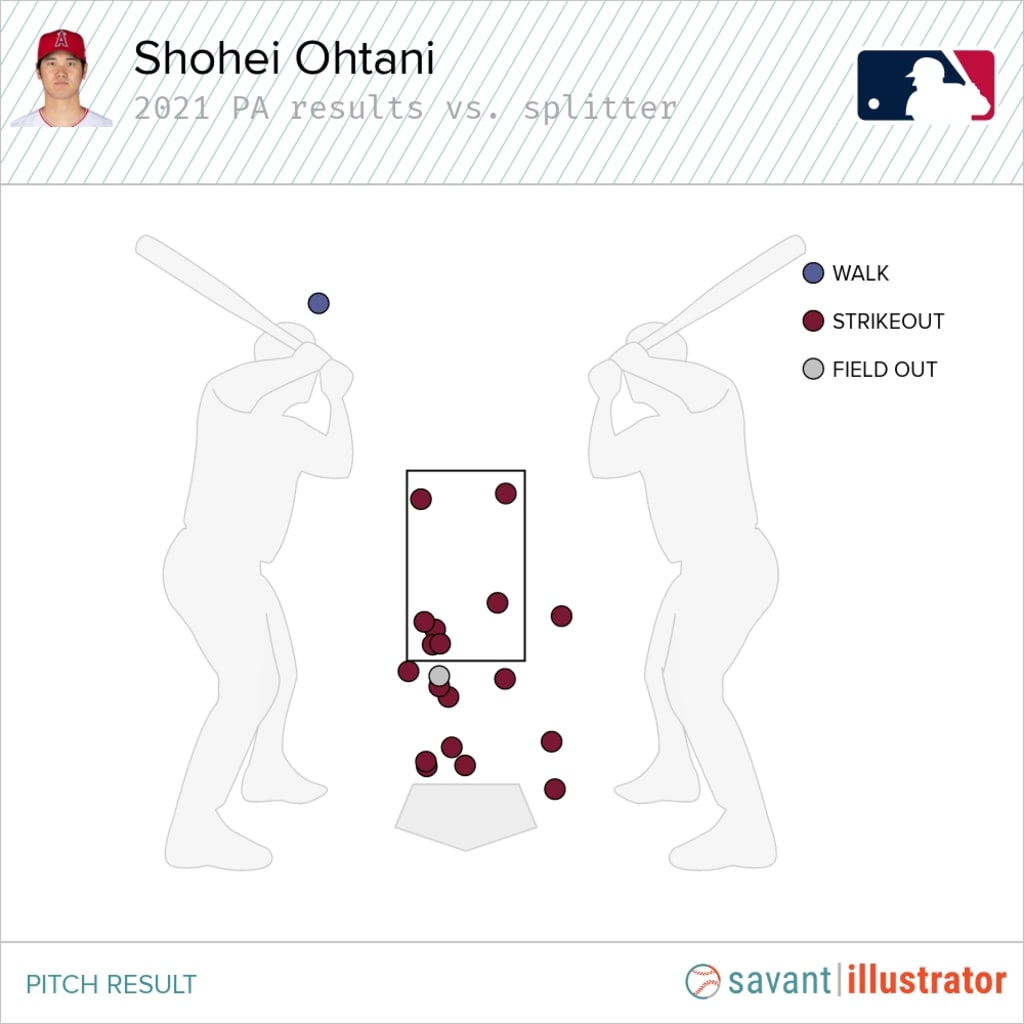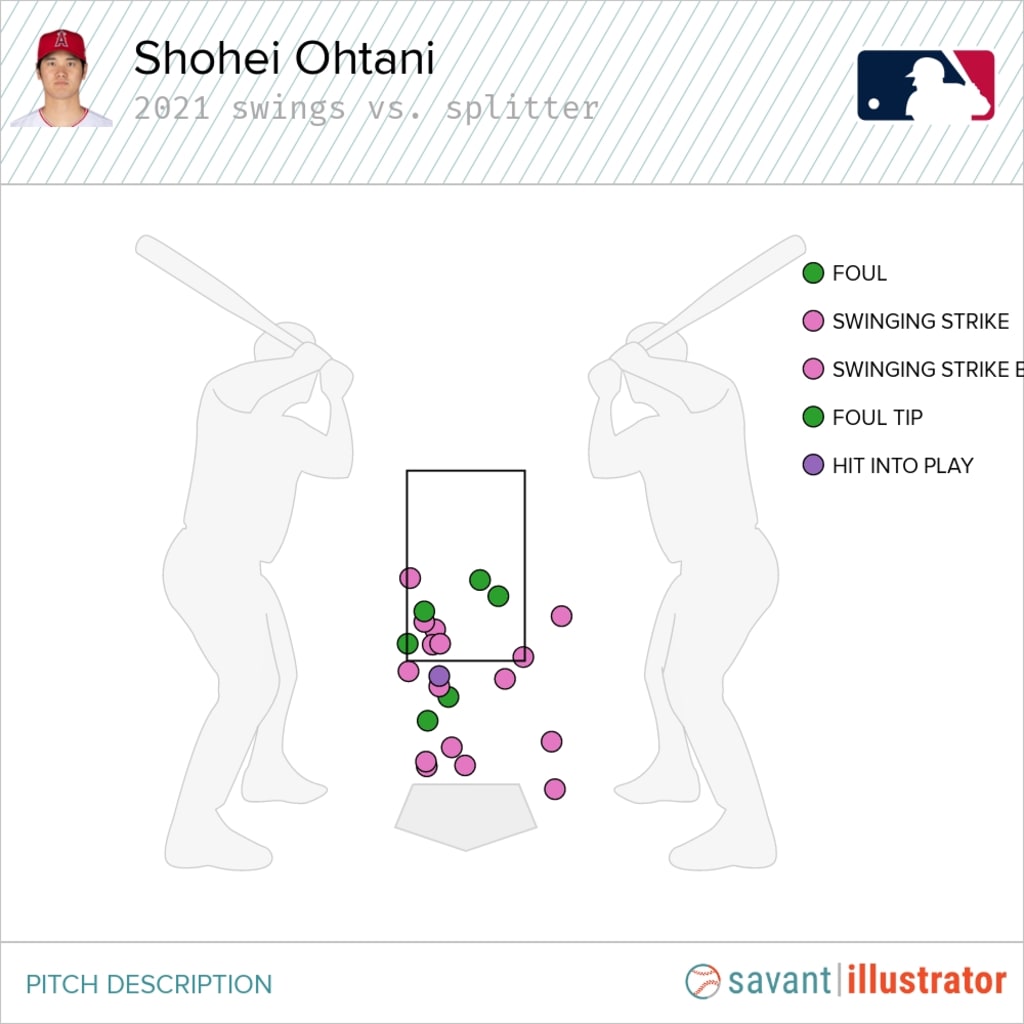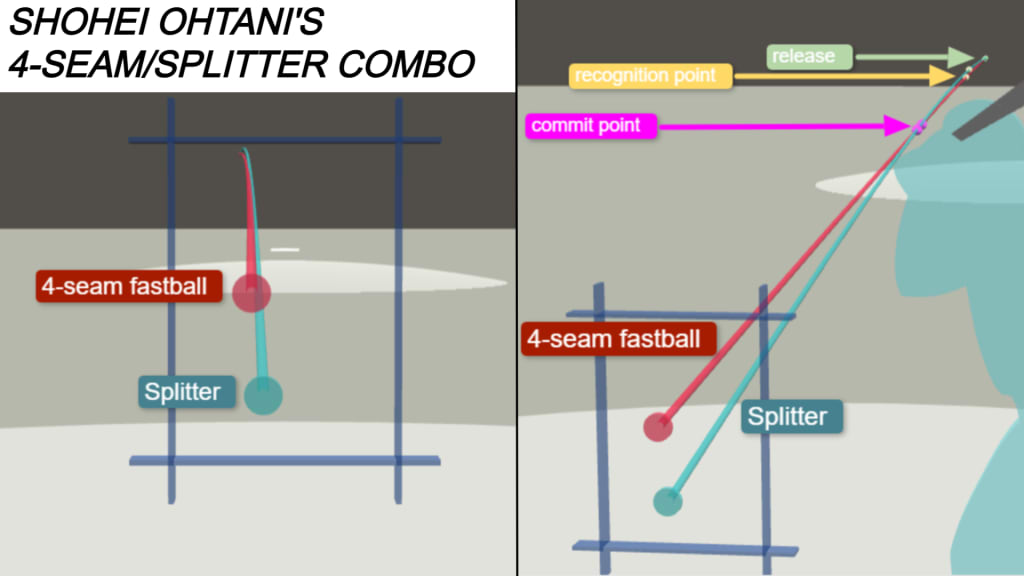The most unhittable pitch in baseball is back -- and maybe even more unhittable than it was before.
We're talking about Shohei Ohtani's splitter. Remember how, in 2018, hitters went 2-for-55 against it, striking out 35 times? Well, you should see what's happening in 2021.
In 20 plate appearances ending on Ohtani's splitter this season, hitters are 0-for-19 … with 18 strikeouts.
You read that right. Ohtani hasn't just held opponents hitless with his splitter, he's finished off all but one of the at-bats with a strikeout. Only one batter has even put Ohtani's splitter in play, let alone gotten a hit (Leury García grounded out against it). Hitters are striking out in 90% of their plate appearances against the Ohtani split. That's crazy.
Highest strikeout rate with a single pitch type, 2021
Minimum 20 PA ending on that pitch type
- Shohei Ohtani's splitter: 90% (18 of 20 PA)
- Dustin May's curveball: 70% (16 of 23 PA)
- Tyler Glasnow's curveball: 68% (30 of 44 PA)
- Rex Brothers' slider: 65% (15 of 23 PA)
- Cristian Javier's slider: 63% (15 of 24 PA)
There are only four pitches in baseball right now that hitters have gone hitless against in 20 or more plate appearances: Ohtani's splitter, Dustin May's curveball, Carlos Rodón's slider and Will Smith's slider. All of them are nasty. But Ohtani's split has been the best strikeout pitch of them all.

In case you were wondering, the one hitter to reach base against Ohtani's splitter is reigning American League MVP José Abreu, who drew a walk against it on a full-count splitter that Ohtani helicoptered way up and out of the strike zone. No one else has been so lucky.
Adam Eaton was the first to strike out against Ohtani's splitter. Then came Yermín Mercedes. Then Abreu, Luis Robert, Yoán Moncada, Nick Solak, Willie Calhoun, Jose Trevino, Isaiah Kiner-Falefa, Joey Gallo, Kiner-Falefa again, Brock Holt, Kiner-Falefa a third time, Gallo a second time, Adolis García, David Dahl, Trevino again and Gallo once more. Fifteen of those 18 strikeout victims went down swinging.
In total, hitters have swung 23 times at Ohtani's splitter so far. They've whiffed on 17 of those swings. That's three-quarters of their swings. Ohtani's splitter is generating the highest swing-and-miss rate of any individual pitch in MLB.
Highest whiff rate with a single pitch type, 2021 Minimum 20 swings vs. that pitch type
- Shohei Ohtani's splitter: 74%
- Josh Staumont's curveball: 73%
- (tie) Corbin Burnes' slider: 67%
- (tie) Corbin Burnes' changeup: 67%
- (tie) Corey Kluber's changeup: 67%

Ohtani has ramped up his splitter velocity this season, and that's made it filthier than ever. He's averaging 89.9 mph on the split-finger in 2021, up over two-and-a-half ticks from the 87.3 mph he averaged as a rookie in 2018.
He's routinely throwing splitters in the low 90s -- 11 of his 23 swinging strikes have been on splitters 90 mph or faster, as have 11 of his 18 K's. That includes an especially ridiculous 92.6 mph splitter to strike out Robert on April 4.
The secret to Ohtani's splitter is the direction of its movement. It is a purely vertical splitter, which looks almost identical to his four-seam fastball … until it doesn't.
Ohtani throws a true four-seamer. It comes straight at the hitter, with barely any horizontal movement. His splitter also comes straight at the hitter -- but then the bottom drops out.
Check out the movement profile of the two pitches. Ohtani's four-seamer and splitter approach the hitter along the same path: His fastball averages 4.6 inches of horizontal movement, and his splitter averages 4.2 inches of horizontal movement. But his four-seamer only drops 12.7 inches on its way to the plate. His splitter drops 32.1 inches -- nearly 20 inches more.
The movement on Ohtani's splitter is straight up and down, a contrast with other splitters that fade to the pitcher's arm side. But that makes it the perfect weapon to pair with his four-seamer, which carries straight through the zone.

One last thing that shows you how Ohtani's splitter works. With Statcast's new spin axis data, we can see how Ohtani throws his four-seamer and splitter with close to the same spin direction. That means when they leave Ohtani's hand, they look the same. But by the time they get to the plate, the movement on the splitter has separated it significantly from the fastball.

Imagine being a hitter who has to tell those two pitches apart -- especially when Ohtani's fastball is coming in at 100-plus mph, and his splitter, an "offspeed" pitch, is coming in at 90-plus mph. That makes it a lot easier to understand 18 strikeouts in 19 at-bats … and a little harder to understand how it isn't 19 out of 19.
